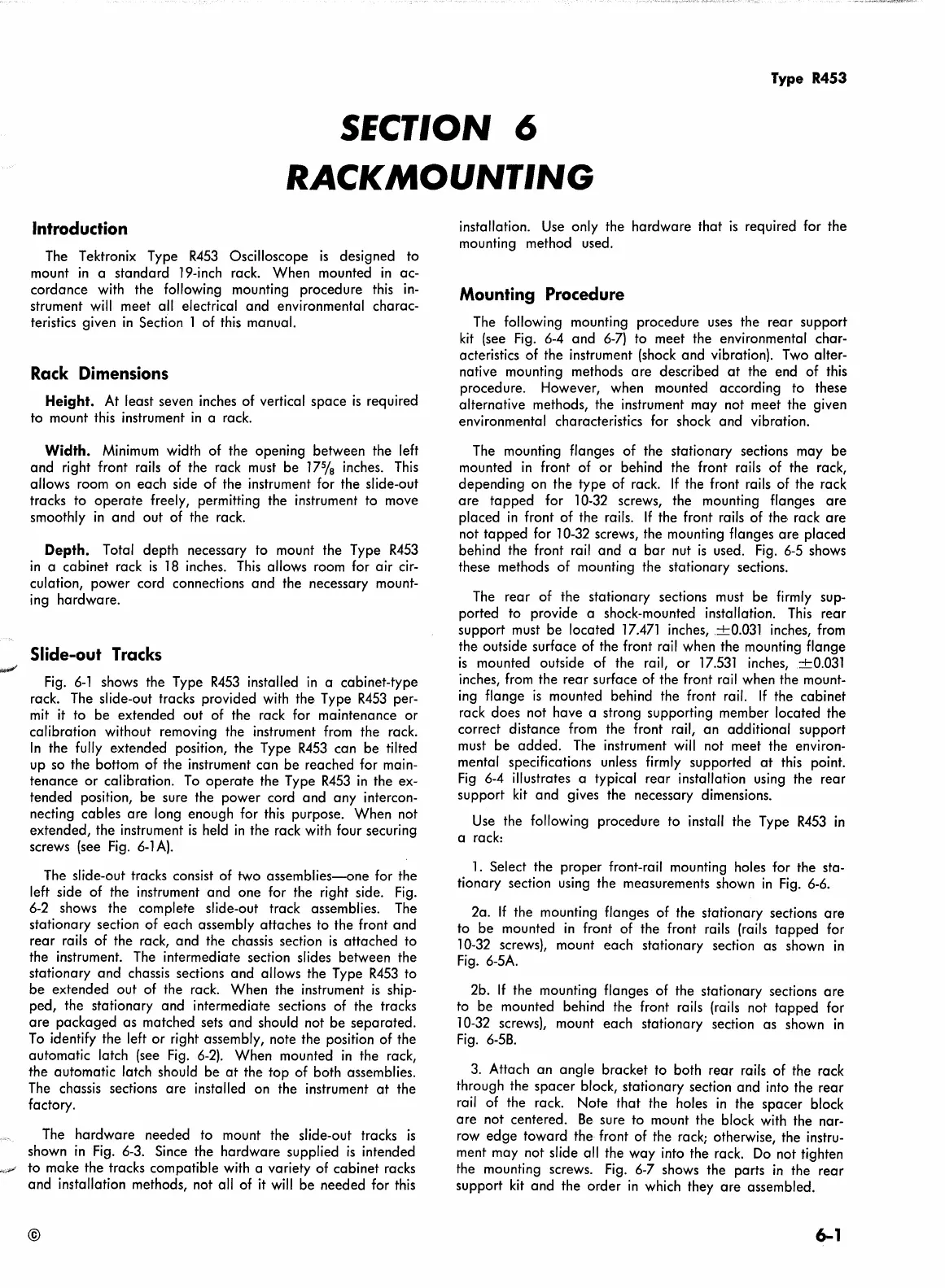Type R453
SECTION 6
RACKMOUNTING
Introduction
The Tektronix Type
R453
Oscilloscope
is
designed
to
mount
in
a
standard
19-inch rack.
When
mounted
in
ac-
cordance
with the following mounting
procedure
this in-
strument will
meet
all electrical
and
environmental
charac-
teristics given
in
Section l
of
this manual.
Rack Dimensions
Height. At least seven inches
of
vertical
space
is
required
to
mount this instrument
in
a rack.
Width. Minimum width of the
opening
between
the left
and
right front rails
of
the rack must
be
17%
inches. This
allows room
on
each
side
of
the instrument for the slide-out
tracks
to
operate
freely, permitting the instrument to move
smoothly
in
and
out
of
the
rack.
Depth. Total
depth
necessary
to
mount the Type
R453
in
a
cabinet
rack
is
18 inches. This allows room for
air
cir-
culation,
power
cord connections
and
the necessary mount-
ing
hardware.
Slide-out Tracks
Fig.
6-1
shows the Type
R453
installed
in
a
cabinet-type
rack. The slide-out tracks provided with
the
Type
R453
per-
mit it
to
be
extended
out
of
the rack for
maintenance
or
calibration without removing the instrument from
the
rack.
In
the fully
extended
position, the Type
R453
can
be
tilted
up so the bottom
of
the instrument
can
be
reached
for main-
tenance
or
calibration. To
operate
the Type
R453
in
the ex-
tended
position,
be
sure the
power
cord
and
any
intercon-
necting
cables
are
long
enough
for this purpose.
When
not
extended,
the instrument
is
held
in
the rack with four securing
screws (see Fig.
6-1
A).
The slide-out tracks consist
of
two
assemblies-one
for the
left
side
of
the instrument
and
one
for the right side. Fig.
6-2 shows the complete slide-out track assemblies. The
stationary
section
of
each
assembly
attaches
to
the front
and
rear
rails
of
the rack,
and
the chassis section
is
attached
to
the instrument. The intermediate section slides
between
the
stationary
and
chassis sections
and
allows the Type
R453
to
be
extended
out
of the rack.
When
the instrument
is
ship-
ped,
the
stationary
and
intermediate sections of the tracks
are
packaged
as
matched sets
and
should not
be
separated.
To identify the left
or
right assembly, note the position of the
automatic
latch (see Fig. 6-2).
When
mounted
in
the rack,
the
automatic
latch should
be
at
the
top
of
both assemblies.
The chassis sections
are
installed on the instrument
at
the
factory.
The
hardware
needed
to
mount the slide-out tracks
is
shown
in
Fig. 6-3. Since the
hardware
supplied
is
intended
to
make the tracks
compatible
with a variety of
cabinet
racks
and
installation methods, not all of it will
be
needed
for this
©
installation. Use only the
hardware
that
is
required for
the
mounting method used.
Mounting Procedure
The following mounting
procedure
uses the
rear
support
kit
(see Fig. 6-4
and
6-7)
to
meet
the environmental char-
acteristics of the instrument (shock
and
vibration). Two alter-
native mounting methods
are
described
at
the
end
of
this
procedure.
However, when mounted
according
to
these
alternative
methods, the instrument
may
not
meet
the given
environmental characteristics for shock
and
vibration.
The mounting flanges
of
the
stationary
sections
may
be
mounted
in
front
of
or
behind the front rails
of
the rack,
depending
on
the
type
of
rack.
If
the front rails
of
the rack
are
tapped
for l 0-32 screws, the mounting flanges
are
placed
in
front
of
the rails.
If
the front rails
of
the.
rack
are
not
tapped
for l 0-32 screws, the mounting flanges
are
placed
behind the front rail
and
a
bar
nut
is
used. Fig. 6-5 shows
these methods
of
mounting the
stationary
sections.
The
rear
of
the stationary sections must
be
firmly sup-
ported
to
provide
a shock-mounted installation. This
rear
support
must
be
located
17.471 inches,
+0.031
inches, from
the outside surface of the front rail when the mounting
flange
is
mounted outside
of
the rail,
or
17.531 inches, .+0.031
inches, from the
rear
surface of the front rail when the mount-
ing
flange
is
mounted behind the front rail.
If
the
cabinet
rack
does
not
have
a strong supporting member
located
the
correct
distance
from the front rail,
an
additional
support
must
be
added.
The instrument will not meet the environ-
mental specifications unless firmly
supported
at
this point.
Fig
6-4 illustrates a typical
rear
installation using the
rear
support
kit
and
gives the necessary dimensions.
Use the following
procedure
to
install the Type
R453
in
a rack:
1.
Select
the
proper
front-rail mounting holes for the sta-
tionary section using the measurements shown
in
Fig. 6-6.
2a.
If
the mounting flanges
of
the stationary sections
are
to
be
mounted
in
front of the front rails (rails
tapped
for
l 0-32 screws}, mount
each
stationary section
as
shown
in
Fig. 6-SA.
2b.
If
the mounting flanges of the stationary sections
are
to
be
mounted behind the front rails (rails not
tapped
for
l 0-32 screws), mount
each
stationary section
as
shown
in
Fig. 6-58.
3. Attach
an
angle
bracket
to
both
rear
rails
of
the rack
through the
spacer
block,
stationary
section
and
into the
rear
rail
of
the rack.
Note
that
the holes
in
the
spacer
block
are
not
centered.
Be
sure
to
mount the block with the nar-
row
edge
toward
the front of the rack; otherwise, the instru-
ment
may
not slide all the
way
into the rack. Do not tighten
the mounting screws. Fig. 6-7 shows the parts
in
the
rear
support
kit
and
the
order
in
which they
are
assembled.
6-1

